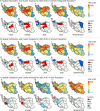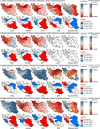Exploring the geospatial epidemiology of breast cancer in Iran: identifying significant risk factors and spatial patterns for evidence-based prevention strategies
- PMID: 38082251
- PMCID: PMC10712175
- DOI: 10.1186/s12885-023-11555-1
Exploring the geospatial epidemiology of breast cancer in Iran: identifying significant risk factors and spatial patterns for evidence-based prevention strategies
Abstract
Background: Breast Cancer (BC) is a formidable global health challenge, and Iran is no exception, with BC accounting for a significant proportion of women's malignancies. To gain deeper insights into the epidemiological characteristics of BC in Iran, this study employs advanced geospatial techniques and feature selection methods to identify significant risk factors and spatial patterns associated with BC incidence.
Methods: Using rigorous statistical methods, geospatial data from Iran, including cancer-related, sociodemographic, healthcare infrastructure, environmental, and air quality data at the provincial level, were meticulously analyzed. Age-standardized incidence rates (ASR) are calculated, and different regression models are used to identify significant variables associated with BC incidence. Spatial analysis techniques, including global and local Moran's index, geographically weighted regression, and Emerging hotspot analysis, were utilized to examine geospatial patterns, identify clustering and hotspots, and assess spatiotemporal distribution of BC incidence.
Results: The findings reveal that BC predominantly affects women (98.03%), with higher incidence rates among those aged 50 to 79. Isfahan (ASR = 26.1) and Yazd (ASR = 25.7) exhibit the highest rates. Significant predictors of BC incidence, such as marriage, tertiary education attainment rate, physician-to-population ratio, and PM2.5 air pollution, are identified through regression models.
Conclusion: The study's results provide valuable information for the development of evidence-based prevention strategies to reduce the burden of BC in Iran. The findings underscore the importance of early detection, health education campaigns, and targeted interventions in high-risk clusters and adjacent regions. The geospatial insights generated by this study have implications for policy-makers, researchers, and public health practitioners, facilitating the formulation of effective BC prevention strategies tailored to the unique epidemiological patterns in Iran.
Keywords: Breast cancer; Geospatial epidemiology; Incidence rate; Iran; Risk factors; Spatial patterns.
© 2023. The Author(s).
Conflict of interest statement
The authors declare no competing interests.
Figures










References
-
- Cancer today [Available from: http://gco.iarc.fr/today/home.
-
- Haghighat S, Omidi Z, Ghanbari-Motlagh A. Trend of breast cancer incidence in Iran during a fifteen-year interval according to national cancer registry reports. Iran J Breast Dis. 2022;15(2):4–17. doi: 10.30699/ijbd.15.2.4. - DOI
MeSH terms
LinkOut - more resources
Full Text Sources
Medical

